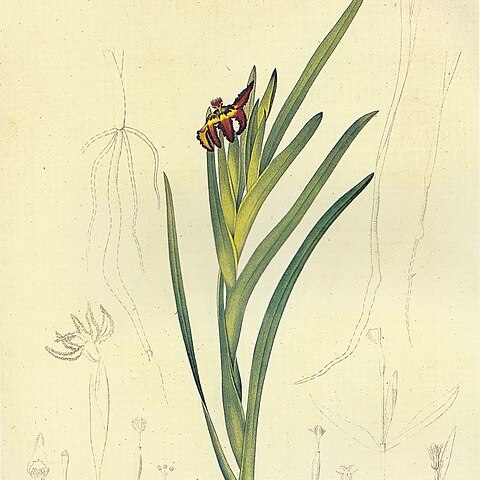Plants (250-)350-500 mm high. Stem well developed, much-branched distally. Leaves sword-shaped to linear, 6-15 mm wide, often with a slightly raised main vein, glaucous, margins sometimes slightly raised, basal leaves longest, cauline leaves progressively shorter above and becoming bract-like. Rhipidia 2-flowered; spathes glaucous, with broad membranous margins, inner 70-85 mm long, outer ± half as long, sheathing entirely or in lower 2/3, then often slightly S-shaped. Flowers on pedicels 6-15 mm long; variously dark chocolate to golden-brown, crisped part of margins similarly coloured or paler, claws pale, streaked with fine longitudinal lines or with a broad median darker centre, forming a cup, 14-18 mm deep, 15-18 mm wide at rim, outer tepals (30-)35-44 x 14-16 mm, inner tepals (28-)36-38 x 8-10 mm, claws of both whorls (13-)16-19 mm long, nectaries at base of claws, ± black or pale yellow-green, 1.3-4.0 mm long. Filaments united in a column 11-13 mm long, free and arching outward in upper ± 3 mm; anther thecae usually widely diverging, initially ± 4 mm long, shrinking after dehiscence; pollen orange. Ovary ellipsoid, 33-42 mm long, including beak 15-20 mm long; style branches ± 2 mm long, dividing into diverging, prominently fringed arms ± 4 mm long; stigmas on small lobes below tips of style arms, arching over anthers. Capsules 15-22 mm long (excluding beak 15-20 mm long). Seeds globose, ± 3 mm diam., pale matte brown, surface lightly wrinkled, epidermal cells concave.
More
Cormous geophyte, 300-450 mm tall, stem reaching well above ground and much branched above. Leaves sword-shaped, crowded basally, usually without a midrib, margins often thickened. Flowers brown to maroon with lighter brown margins or golden-brown with darker margins, claws broad, forming a wide cup, nectaries pale green, large, anther lobes divergent. Capsule beaked. Mainly late Sept.-Nov.
Cormous geophyte to 45 cm, stem reaching well above ground, much-branched above. Leaves sword-shaped, crowded basally. Flowers brown with lighter brown margins or golden brown with darker margins, claws broad, forming a wide cup, nectaries pale green, large, anther lobes diverging, capsules beaked.

